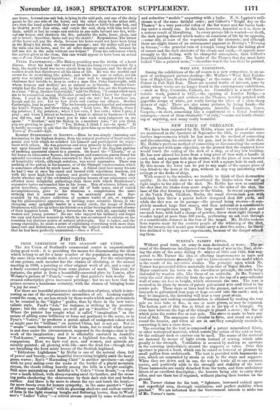fin Arts.
PRIZE EXHIBITION OF THE GLASGOW ART UNION.
The Art Union of Scotland's commercial centre is unquestionably doing good work : it is providing the means for disseminating the ideas which belong to art for a large number of the population among whom the same ideas would make much slower progress. For the subscription of one guinea, each member has the chance of obtaining, at the annual meeting in 1860, a painting or other original work of art, and a copy of a finely executed engraving from some picture of mark. This year, for instance, the print is from a beautifully-executed plate by Lemon, ;fter Webster's picture of "Punch,"—one of that painter's best works. In- creased subscription gives increased privilege ; but we see here that the guinea secures a handsome certainty, with the chance of bringing home
a joy for ever."
For there are beautiful pictures in the collection of prizes, which is inte- resting as one of the representative assemblies of art. Looking rapidly round the room, we are less struck by those works which make pretensions to be counted in the "higher" grades, than by those in the new natu- ralistic style. Feeds "Job," for instance, is striking in the prostrate figure ; but the other figures are well got up " durables" of the stage. Where the painter has sought what is called "imagination" as the means of adding some brilliancy or force not pertinent to the scene, as in Pyne's "Venice," he produces a garish splash of undigested colour such as might pass for " brilliant " on painted China, but is not art. Not to " create " some fantastic crotchet of the brain, but to recall what nature is and does under the circumstances, supposed in the design—that is the work of the imagination ; and it is admirably ereeeind in Ansdell's "Tod-hunter," returning home from a highland fox-chase, with his companions. Here we have real men, and women, and animals ad- mirably painted; all glowing with life—save the dead fox—though they are breathing the keen misty breeze of the Scottish highland. " Eddystone Lighthouse ' by Melby is one of the natural class, full of power and beauty,—the beautiful tower rising brightly amid the heavy green waves ; Roe's "Marauding Chief" is another specimen—an eagle with its prey sailing over the rocks at the border of a placid mountain stream, the clouds rolling heavily among the hills in a bright sunlight. Still more painstaking and faithful is V. Cole's " Cross Roads,"—a view over a heath hillock, with sheep reposing amid the heather, and the cross- ing paths checkering the chiaroscuro by their dark rich tint and broken surface. And there is far more to charm the eye and touch the heart,— far more beauty even for human sympathy, in the same painter's "Lane at Albury near Guildford," withita glancing shadows and endless variety of form in the light crossing boughs and flattering leaves, than in Wool- mer's " Ladies' Valley "—a retired stream peopled by some well-dressed
and seductive "models " coquetting with a bathe. N. 0. Lgpton's mill- stream is of the same faithful order; and Gilbert's " Bright day on the Thames" is a very powerful reflex of the flat water and flat banks bask- ing under a steady sun. In this last, however, beautiful as it is, there is a serious result of literalizing. In every picture life is wanted—or death, the dark jarring discord which makes us conscious of life by its opposite, —some stir, at least of the vegetation and the elements; and although there are slight traces of an unconquered pigment in Hering's "Evening in Greece,"—the graceful ruin of a temple rising before the fading glow of sunset and the dark shadows of the clouds and earth,—it appeals more strongly to the feeling, with its changeful atmosphere, than Gilbert's beautiful finished scene. The banks of the Thames that day must have looked "like a painted scene,"—therefore was it the less fit to be painted.


































 Previous page
Previous page